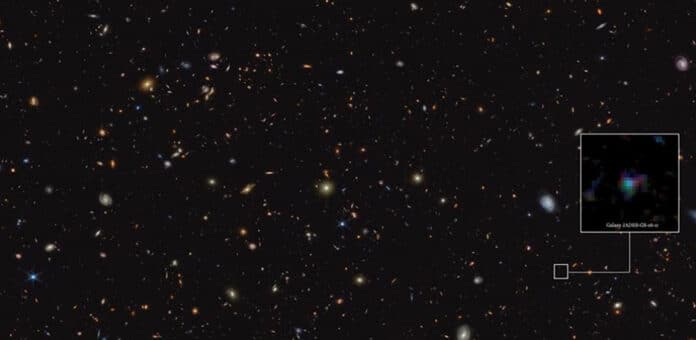For the first time, the James Webb Space Telescope has observed large dust reservoirs in galaxies out to redshift z ∼ 8, when the age of the Universe was only about 600 Myr. The Webb may have observed a different species of carbon-based molecule: possibly minuscule graphite- or diamond-like grains produced by the earliest stars or supernovas.
Similar observational traces have been found in the far more recent Universe and have been linked to polycyclic aromatic hydrocarbons (PAHs). PAHs are complex carbon-based compounds. However, the development of PAHs within the first billion years of cosmic time is not likely.
Astronomers can get information about cosmic dust’s composition by observing the wavelengths of light that it blocks. Using this technique in combination with Webb’s extraordinary sensitivity, astronomers in this study detected the presence of carbon-rich dust grains only a billion years after the birth of the Universe.
Lead author Dr. Joris Witstok from Cambridge‘s Kavli Institute for Cosmology said, “Carbon-rich dust grains can be particularly efficient at absorbing ultraviolet light with a wavelength around 217.5 nanometres, which for the first time we have directly observed in the spectra of very early galaxies.”
This 217.5-nanometer pattern was previously seen in the far more recent and local Universe, including within our Milky Way galaxy. It has been attributed to either polycyclic aromatic hydrocarbons (PAHs) or nanoscale graphitic grains, two different forms of carbon-based molecules.
If the scientists had discovered the chemical signature of molecules that shouldn’t have developed yet, it would be unexpected because most models predict that it will take several hundreds of millions of years for PAHs to form. However, the researchers claim that this finding represents the dust grain’s earliest and farthest direct signature.
The specifics of what was observed may hold the key to the solution. The team’s feature peaked at 226.3 nanometers rather than the 217.5-nanometer wavelength linked to PAHs and minute graphitic granules. Measurement mistakes may cause an error of fewer than 10 nanometers. It also points to a variation in the makeup of the cosmic dust mixture from the early cosmos that the team discovered.
Witsok said, “This slight shift in wavelength of where the absorption is strongest suggests we may be seeing a different mix of grains, for example, graphite- or diamond-like grains. This could also be produced on short timescales by Wolf-Rayet stars or by material ejected from a supernova.”
Astronomers may now do in-depth examinations of the light coming from specific dwarf galaxies that were visible in the first billion years of cosmic time thanks to the development of Webb. Finally, Webb makes it possible to investigate the genesis of cosmic dust and its significance to the vital early phases of galaxy evolution.
Co-author Professor Roberto Maiolino, who is based in the Cavendish Laboratory and the Kavli Institute for Cosmology, said, “This discovery was made possible by the unparalleled sensitivity improvement in near-infrared spectroscopy provided by Webb, and specifically its Near-Infrared Spectrograph (NIRSpec). The increase in sensitivity provided by Webb is equivalent, in the visible, to instantaneously upgrading Galileo’s 37-millimeter telescope to the 8-meter Very Large Telescope, one of the most powerful modern optical telescopes.”
Co-author Irene Shivaei of the University of Arizona/Centro de Astrobiología (CAB) said, “The team is planning further research into the data and this result. We plan to work with theorists who model dust production and growth in galaxies. This will shed light on the origin of dust and heavy elements in the early Universe.”
Co-author Dr. Renske Smit from Liverpool John Moores University said, “I’ve studied galaxies in the first billion years of cosmic time my entire career, and never did we expect to find such a clear signature of cosmic dust in such distant galaxies. The ultradeep data from JWST shows us that grains made up of diamond-like dust can form in the most primordial of systems. This is completely overthrowing models of dust formation and opening up a whole new way of studying the chemical enrichment of the first galaxies.”
Journal Reference:
- Joris Witstok et al. ‘Carbonaceous dust grains seen in the first billion years of cosmic time.’ Nature (2023). DOI: 10.1038/s41586-023-06413-w
